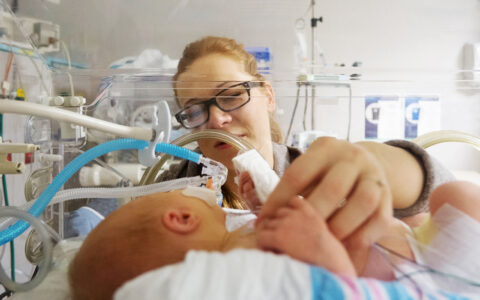A new analysis out of Vanderbilt University Medical Center found rates of neonatal abstinence syndrome (NAS) increased five-and-a-half fold between 2004 and 2016, but have remained steady since 2014. The data were published in Health Affairs.
“Evidence is beginning to show that we’re holding down the rising trend in NAS,” said first author Ashley Leech, Ph.D., an assistant professor of health policy at Vanderbilt University Medical Center.
“While encouraging, rates are significantly higher than they were 20 years ago; we still have more work to do,” she added.
Spikes and Plateaus
Leech and colleagues calculated quarterly NAS rates by dividing in-hospital NAS diagnoses by the number of in-hospital births. They used data from the Healthcare Cost and Utilization Project’s National Inpatient Sample – a total of 10.3 million births during the study period.
Between 2004 and 2016, NAS rates grew from 1.6 to 8.8 per 1,000 births. However, the researchers found “NAS rates did not change substantially” during the peak period from 2014 to 2016. An estimated 31,765 infants received an NAS diagnosis in U.S. hospitals in 2016.
“In 2016, one baby was born every 15 minutes with NAS,” Leech said. “Rates may have plateaued, but are still high, and there is a need for continued action to improve outcomes for pregnant women and infants affected by the opioid crisis.”
“Rates may have plateaued, but are still high, and there is a need for continued action.”
Population Trends
Infants with NAS are often irritable, with increased muscle tone, tremors, seizures, difficulty feeding or breathing problems. They are most often born to mothers with chronic opioid use during pregnancy, or who used medications for opioid use disorder such as buprenorphine or methadone. Polysubstance use can increase NAS severity.
According to the report, the incidence of NAS was highest in the Northeast U.S. (up to 12 per 1,000 births in late 2014). However, the overall number of new cases was highest in the South (13,410 NAS diagnoses, or 42.2 percent of the total). The findings corroborate other analyses of NAS geographic distribution.
The researchers also found infants who received an in-hospital NAS diagnosis were more commonly male (53.2 percent), non-Hispanic Caucasian (72.5 percent) and born to mothers who use public insurance (84.3 percent).
Ongoing Prevention
The plateau in NAS diagnoses aligns with national trends showing fewer opioid overdose deaths in recent years and could reflect policy changes designed to combat opioid use disorder, said senior author Stephen Patrick, M.D., director of the Vanderbilt Center for Child Health Policy.
“Recent federal policy changes like the SUPPORT Act were steps towards supporting moms and babies affected by the opioid crisis,” Patrick said. “What’s critical is for decision makers hoping to reduce the effect of the opioid crisis on pregnant women and infants to continue to promote evidence-based policies that improve treatment access and reduce punitive measures. We know these steps improve outcomes for both mom and baby.”
At Vanderbilt, Team HOPE works to keep opioid-exposed mothers and their babies together in the hospital and uses a pre-discharge checklist to ensure they are connected to follow-up care. The initiative has reduced length of stay and readmissions for NAS infants.







